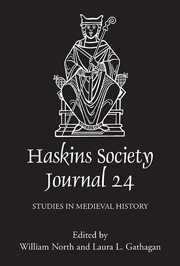Book contents
- Frontmatter
- Contents
- List of Figures
- Editor's Note
- Abbreviations
- 1 ‘Those Five Knights which you Owe me in Respect of your Abbacy’. Organizing Military Service after the Norman Conquest: Evesham and Beyond
- 2 Voluntary Ascetic Flagellation: From Local to Learned Traditions
- 3 The Material and the Visual: Objects and Memories in the Historia ecclesiastica of Orderic Vitalis
- 4 Anonymus Vaticanus: Another Source for the Normans in the South?
- 5 Christian Community and the Crusades: Religious and Social Practices in the De expugnatione Lyxbonensi
- 6 Godric of Finchale's Canora Modulatio: The Auditory and Visionary Worlds of a Twelfth-Century Hermit
- 7 Did Portugal Have a Twelfth-Century Renaissance?
- 8 Internal and External Audiences: Reflections on the Anglo-Saxon Archive of Bury St Edmunds Abbey in Suffolk
5 - Christian Community and the Crusades: Religious and Social Practices in the De expugnatione Lyxbonensi
Published online by Cambridge University Press: 05 December 2013
- Frontmatter
- Contents
- List of Figures
- Editor's Note
- Abbreviations
- 1 ‘Those Five Knights which you Owe me in Respect of your Abbacy’. Organizing Military Service after the Norman Conquest: Evesham and Beyond
- 2 Voluntary Ascetic Flagellation: From Local to Learned Traditions
- 3 The Material and the Visual: Objects and Memories in the Historia ecclesiastica of Orderic Vitalis
- 4 Anonymus Vaticanus: Another Source for the Normans in the South?
- 5 Christian Community and the Crusades: Religious and Social Practices in the De expugnatione Lyxbonensi
- 6 Godric of Finchale's Canora Modulatio: The Auditory and Visionary Worlds of a Twelfth-Century Hermit
- 7 Did Portugal Have a Twelfth-Century Renaissance?
- 8 Internal and External Audiences: Reflections on the Anglo-Saxon Archive of Bury St Edmunds Abbey in Suffolk
Summary
The study of crusading religious practices has often focused on practices undertaken at home or at the beginning of a crusade, such as liturgy or the practice of taking the cross. In contrast, the religious practices performed routinely during the crusade itself have been relatively less explored. Yet, analyzing the devotional activities of crusaders while they were actually on crusade has the potential to illuminate not only the crusading movement but also points of intersection and divergence between that movement and larger cultural trends. Furthermore, although some crusading accounts admittedly provide little information on the religious practices of crusaders, others are more forthcoming. Among these, the Anglo-Norman account of the 1147 conquest of Lisbon during the Second Crusade, the De expugnatione Lyxbonensi, is a particularly rich source of information on the daily religious lives of men and women on crusade.
As I will demonstrate, religious practices in the De expugnatione Lyxbonensi resonate with ideals and themes active in both contemporary monastic reform and the development of lay piety. Furthermore, they are articulated via the social customs associated with coniuratio, a sworn, oath-bound society. A connection between crusading and monastic ideals is hardly surprising, ever since Jonathan Riley-Smith noted that the First Crusaders were in effect ‘a military monastery on the move’. For the most part, however, historians' development of this idea has understandably focused on the ways in which crusaders were like monks and/or inhabited a similar ideological universe to that of advocates of reform monasticism.
- Type
- Chapter
- Information
- The Haskins Society Journal 242012 Studies in Medieval History, pp. 95 - 126Publisher: Boydell & BrewerPrint publication year: 2013

